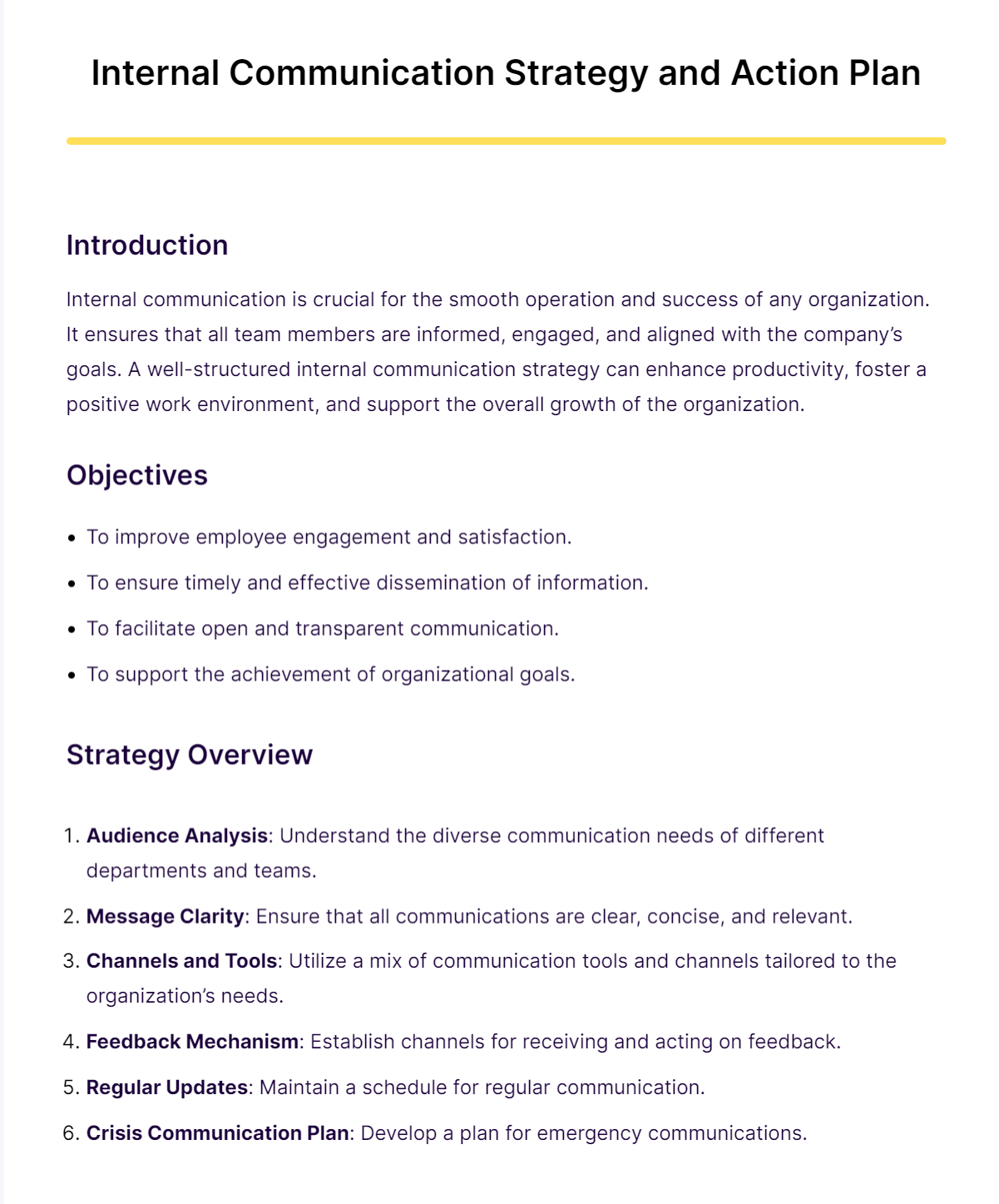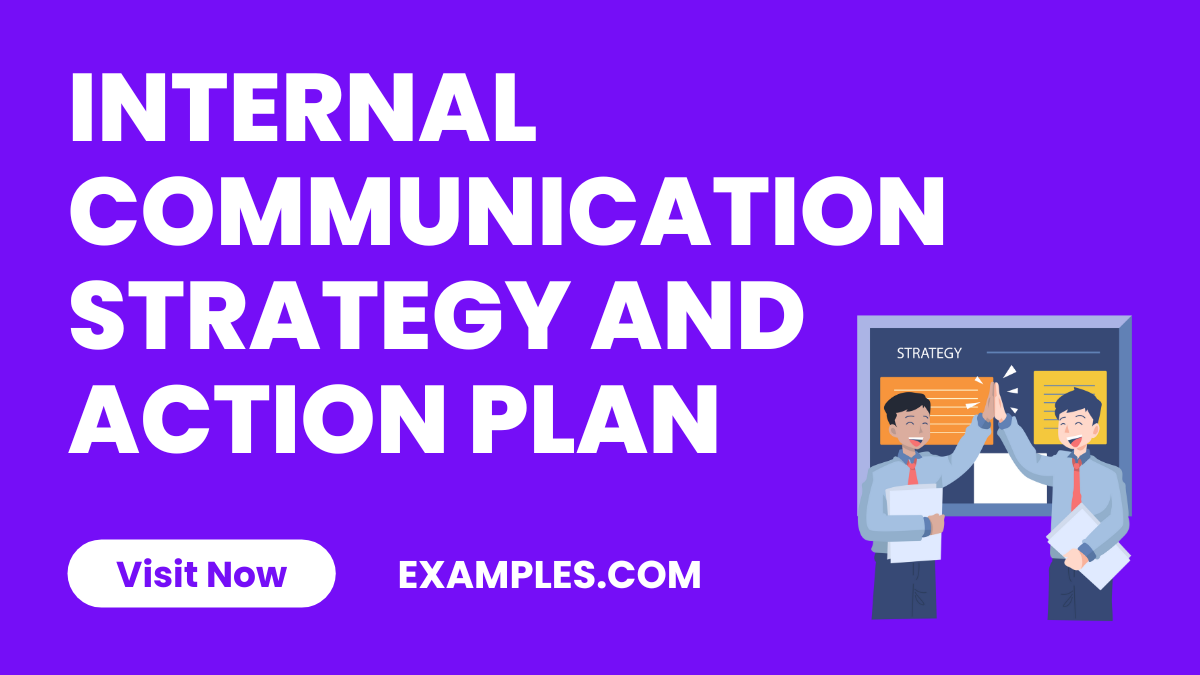Internal Communication Strategy and Action Plan Example [Edit & Download]
An Internal Communication Strategy and Action Plan is crucial for any thriving organization. This complete guide, enriched with practical communication examples, lays the foundation for a seamless flow of information within a company. It delves into the strategic steps necessary to build effective internal channels, ensuring that every team member is aligned and informed. From outlining corporate messaging guidelines to integrating the latest internal communication tools, this guide serves as a comprehensive resource for enhancing workplace communication and collaboration.
Internal Communication Strategy and Action Plan

The comprehensive guide for developing an internal communication strategy and action plan. It emphasizes the importance of aligning the communication strategy with organizational goals, improving employee engagement, and ensuring timely information dissemination. The guide covers various aspects, including audience analysis, message clarity, utilizing diverse communication tools and channels, establishing feedback mechanisms, regular updates, and crisis communication plans. It also highlights the importance of measurement and evaluation to ensure the strategy’s effectiveness and contribution to organizational culture and goals.
What a Smart Internal Communication Strategy and Action Plan Achieves?
A well-crafted Internal Communication Strategy and Action Plan is more than just a set of guidelines; it’s a transformative tool that can significantly enhance the operational efficiency and morale of an organization. Here’s what a smart plan achieves:
Fosters a Unified Corporate Culture
An intelligent internal communication strategy helps cultivate a strong, unified corporate culture. It ensures that all employees understand and align with the company’s core values, mission, and vision. By consistently reinforcing the organization’s ethos through strategic communication, employees feel more connected to the company’s objectives, fostering a sense of belonging and loyalty.
Boosts Employee Engagement
Effective internal communication keeps employees informed, engaged, and motivated. When team members are aware of what’s happening in the organization, they feel valued and included. Regular updates, feedback mechanisms, and open forums for discussion encourage active participation and can significantly boost morale and productivity.
Enhances Collaboration and Teamwork
A smart plan leverages internal communication tools to facilitate better collaboration and teamwork. By providing platforms for sharing ideas and feedback, employees can work together more effectively, regardless of their physical location. This not only speeds up project timelines but also encourages a more innovative and inclusive work environment.
Manages Change Effectively
Organizations are constantly evolving, and a robust communication strategy helps manage this change effectively. By clearly communicating the reasons, benefits, and implications of any changes, and by providing a platform for addressing concerns and feedback, the strategy minimizes resistance and confusion, ensuring a smoother transition.
Improves Information Flow and Reduces Miscommunication
An intelligently designed communication plan establishes clear protocols for information flow, reducing the chances of miscommunication. It ensures that the right information reaches the right people at the right time, through the right channels, thereby improving decision-making and reducing errors.
Supports Crisis Management
In times of crisis, effective communication is crucial. A well-prepared plan includes crisis communication protocols that outline how to communicate quickly and effectively to manage the situation. It helps in controlling the narrative, reducing panic, and providing clear instructions to mitigate the impact.
Encourages Continuous Improvement
Finally, a smart internal communication plan strategy isn’t static; it’s designed to evolve. By including mechanisms for regular feedback and evaluation, the plan encourages continuous improvement. It adapts to the changing needs of the organization and its workforce, ensuring long-term effectiveness and relevance.
How to Create a Internal Communications Strategy and Action Plan?
Creating an Internal Communications Strategy and Action Plan is pivotal for fostering a transparent, efficient, and cohesive environment within any organization. Here’s a detailed guide to help you develop a strategy that’s optimized for “Internal Communication Strategy and Action Plan”:
Step 1: Define Your Objectives
Objective: Clearly outline what you aim to achieve with your internal communications. This might include improving employee engagement, ensuring everyone is informed about company changes, or enhancing collaboration across departments.
- How: Align these objectives with your overall business strategy.
- Considerations: Use SMART criteria (Specific, Measurable, Achievable, Relevant, Time-bound) to define these objectives.
Step 2: Conduct an Internal Audit
Objective: Understand the current state of internal communications in your organization.
- How: Use an external communication plan audit template to assess the effectiveness of current communication tools and strategies.
- Considerations: Identify gaps, areas for improvement, and what is currently working well.
Step 3: Identify Your Audience
Objective: Recognize and segment your internal audience to tailor your communications effectively.
- How: Create profiles for different groups within your organization, considering their roles, preferences, and communication needs.
- Considerations: Remember that one size does not fit all; different groups may require different approaches.
Step 4: Develop Your Key Messages
Objective: Craft clear and concise messages that resonate with your audience.
- How: Use a key message development framework to ensure consistency and clarity.
- Considerations: Messages should be relevant, engaging, and reflect your corporate values and culture.
Step 5: Choose the Right Channels
Objective: Select the most effective channels to reach your audience.
- How: Refer to your internal communication tools list and decide based on the preferences and habits of your audience segments.
- Considerations: Balance between digital tools (like emails, intranets, and social platforms) and traditional methods (meetings, notice boards).
Step 6: Create a Detailed Action Plan
Objective: Outline the specific actions, responsible persons, timelines, and resources needed.
- How: Develop a team collaboration plan outline that details every step.
- Considerations: Ensure the plan is flexible enough to accommodate changes and updates.
Step 7: Establish Crisis Communication Protocols
Objective: Prepare for potential crises by having a clear communication strategy in place.
- How: Define scenarios and create a response strategy as part of your crisis communication protocols.
- Considerations: Rapid and transparent communication is key during a crisis.
Step 8: Implement, Evaluate, and Adjust
Objective: Put your plan into action and continually assess its effectiveness.
- How: Regularly collect feedback and use communication campaign evaluation criteria to measure success.
- Considerations: Be prepared to make adjustments based on feedback and changing needs within the organization.
What are the Components of a Internal Communication Strategy and Action Plan?
An effective Internal Communication Strategy and Action Plan is composed of several crucial components that work together to ensure clear, consistent, and engaging communication within an organization. Here are the five key components:
1. Clear Objectives
Objective: Define what the internal communication strategy aims to achieve.
- Details: Objectives should be aligned with the overall business goals and may include improving employee engagement, ensuring timely information dissemination, or fostering a positive corporate culture.
- Importance: Clear objectives provide a direction and purpose for all communication efforts, making it easier to measure success and make improvements.
2. Audience Segmentation
Objective: Identify and understand the different groups within the organization.
- Details: Segmenting the audience allows for tailored communication that addresses the specific needs, preferences, and roles of different employee groups.
- Importance: Targeted communication ensures that the right message reaches the right people at the right time, enhancing relevance and effectiveness.
3. Content and Messaging
Objective: Develop key messages that resonate with the audience and reflect the organization’s values.
- Details: This involves creating a key message development framework and ensuring all communication is clear, consistent, and in line with the corporate messaging guidelines.
- Importance: Well-crafted messages prevent misunderstandings, build trust, and reinforce the company’s brand and culture.
4. Communication Channels and Tools
Objective: Select the most appropriate channels and tools to reach the audience effectively.
- Details: This may include a mix of digital tools (e.g., emails, intranets, social platforms) and traditional methods (e.g., face-to-face meetings, notice boards) as identified in the internal communication tools list.
- Importance: The right channels ensure that messages are delivered efficiently and received by the intended audience, fostering better engagement and feedback.
5. Measurement and Evaluation
Objective: Continuously assess the effectiveness of the communication strategy and make necessary adjustments.
- Details: Establish communication campaign evaluation criteria and conduct regular audits using tools like an external communication audit template.
- Importance: Regular evaluation helps identify what’s working and what’s not, allowing for timely adjustments and continuous improvement of the communication strategy.
Benefits of an Internal Communication Strategy and Action Plan Template
An Internal Communication Strategy and Action Plan Template offers numerous advantages for organizations aiming to enhance their internal communication processes:
Streamlined Development Process
- Efficiency: A template simplifies the process of creating a strategy, saving valuable time and resources.
- Guidance: It provides a structured approach, guiding users through each essential step.
Consistency and Clarity
- Uniformity: Ensures all aspects of internal communication are consistent with the organization’s goals and culture.
- Clear Objectives: Helps in setting clear, measurable objectives for internal communication efforts.
Customizable and Adaptable
- Flexibility: Templates can be tailored to fit the unique needs of different organizations.
- Scalability: Adapts to varying sizes and types of organizations, from small businesses to large corporations.
Risk Mitigation
- Preemptive Planning: Aids in identifying potential risks and developing strategies to mitigate them.
- Proactive Approach: Encourages consideration of various scenarios, preparing the organization for unexpected challenges.
Evaluation and Improvement
- Measurable Outcomes: Facilitates the setting of benchmarks and KPIs to measure the effectiveness of internal communications.
- Continuous Improvement: Enables regular review and updates to the strategy, ensuring it remains relevant and effective.
Utilizing an Internal Communication Strategy and Action Plan Template is an efficient way to structure and streamline the development of your organization’s communication strategy. Here’s how to make the most of such a template:
- Customization: Begin by customizing the template to suit your organization’s specific needs. Adjust sections like objectives, target audience, and channels to reflect your unique circumstances.
- Define Objectives: Clearly articulate your organizational communication objectives in the template. Ensure these objectives are aligned with your overall business goals.
- Identify Audience: Use the template to segment your internal audience. Customize communication strategies for different groups within the organization.
- Select Channels: The template should include a section for selecting communication channels. Fill this in based on your audience analysis and the internal communication tools list you have.
- Develop Key Messages: Utilize the key message development framework section to create clear, consistent messages that align with your corporate values.
- Action Plan: The template should have a section for an action plan. Outline specific steps, timelines, and responsible parties.
- Risk Management: Use the risk assessment section to identify potential challenges and plan mitigation strategies.
- Budget Considerations: Include a budget section to ensure financial resources are allocated effectively.
- Evaluation and Feedback: Set up communication campaign evaluation criteria for measuring the effectiveness of the strategy.
- Regular Updates: Amend and update the template regularly to reflect changes in the organization or its environment.
The linked page from the Local Government Association provides guidance on creating an internal communications strategy. It emphasizes the strategy’s importance in focusing activities on what matters most to staff and the organization. It also outlines the key topics an effective internal communications strategy should cover, including current state analysis, defining objectives, planning for achievement, action plans, resource considerations, risk identification, and the importance of regular evaluation.
To build a brilliant internal communication plan and strategy, start by defining clear objectives aligned with your organization’s goals. Understand your audience and tailor messages accordingly. Choose the right mix of communication tools, like intranets, emails, and instant messaging, to suit different needs. Encourage two-way communication by establishing feedback channels. Regularly measure the effectiveness through surveys and analytics, and be prepared to adapt and improve continuously. Remember, transparency, consistency, and engagement are key to keeping employees informed, motivated, and aligned with the company’s vision and objectives.



